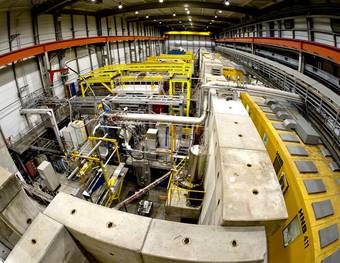Neuer exotischer Teilchenzustand gibt Rätsel auf
2015-09-04 – Nachrichten aus dem Physik-Department

Quarks sind dem Standardmodell der Teilchenphysik zufolge die fundamentalen Bausteine, aus denen Atomkerne aufgebaut sind: Ein Proton besteht aus einem up- und zwei down-Quarks, ein Neutron aus einem down und zwei up-Quarks. Damit ist der Teilchenzoo der Quarks jedoch noch lange nicht komplett: Neben den beiden leichtesten Quarks gibt es noch vier weitere: das strange-, charm-, bottom- und das top-Quark sowie ihre jeweiligen Antiteilchen, die Antiquarks.
Alle diese Quarks waren kurz nach dem Urknall vorhanden und spielten eine wichtige Rolle bei der Entstehung unseres Universums. Die vier schweren Quarks sind in den Naturvorgängen in unserer Umgebung nicht mehr zu beobachten. Um sie nachzuweisen, werden große Teilchenbeschleuniger benötigt. Zusammengehalten werden die Quarks durch „Klebeteilchen“, Gluonen, die auch die starke Wechselwirkung, die stärkste der vier Fundamentalkräfte der Physik, vermitteln.
Die starke Wechselwirkung wird durch eine Theorie beschrieben, die sich Quantenchromodynamik (QCD) nennt und in den 1980-er Jahren entwickelt wurde. Mit ihrer Hilfe wollen die Physiker beschreiben, nach welchen Prinzipien sich Materie formt und welche Konfigurationen von Teilchen die Natur zulässt. Die QCD sagt dabei eine ganze Reihe von Quark-Kombinationen voraus.
Einige davon sind gut bekannt: Eine Kombination von drei Quarks (Baryonen), wie sie etwa in den Protonen und Neutronen vorkommen, sowie eine Kombination aus einem Quark- und einem Antiquark (Mesonen), wie sie etwa die Pionen aufweisen. Auch einige exotische Kombinationen, wie zum Beispiel molekülähnliche Vierfach-Quarks oder sogar Fünffach-Quarks, sind der QCD zufolge möglich. Kürzlich wurden am LHC tatsächlich Hinweise auf ein solches Fünffach-Quark gefunden.
Die Kombinationsregeln von Quarks zu verstehen, ist seit langem eine große Herausforderung für die theoretische wie auch die experimentelle Teilchenphysik. Dabei erschwert ein äußerst ungewöhnliches Phänomen das Verständnis der Quark-Kombination: Die Kräfte zwischen den Quarks werden immer größer, je weiter man diese voneinander entfernt. Die starke Wechselwirkung wächst also, anders als die anderen drei Grundkräfte, mit zunehmendem Abstand der Teilchen. Die zugehörigen QCD-Gleichungen stellen eine der großen Herausforderungen in der theoretischen Physik dar. Eine Annäherung an die Lösung wird vor allem mit Computersimulationen erreicht, die sehr viel Rechenzeit beanspruchen, aber mögliche Teilchenkombinationen deutlich einschränken.
In ihrer neuesten Publikation macht die COMPASS-Kollaboration die Existenz eines ungewöhnlichen Mesons öffentlich, das sich aus leichten Quarks zusammensetzt und eine Masse von 1,42 GeV/c2 hat. Da in dieser Massenregion seit einem halben Jahrhundert geforscht wird, ist die Entdeckung des neuen Teilchens mit Hilfe des COMPASS-Spektrometers am Super Proton Synchrotron (SPS) am CERN eine große Überraschung. Diese ist dem weltweit größten Datensatz für solche Untersuchungen zu verdanken.
Das neue a1(1420) genannte Teilchen wurde bei Datenanalysen von Experimenten gefunden, bei denen Pionen mit einem Impuls von 190 GeV/c auf ein Flüssig-Wasserstoff-Target geschossen wurden. Weil dieser neue Zustand rund 1.000 Mal seltener vorkommt als die bekannten Mesonen, war zur Identifizierung eine neue, komplexe Analysemethode nötig, für die Wissenschaftler des Exzellenzclusters Universe der Technischen Universität München (TUM) zuständig waren.
Für das neue Teilchen wurden verschiedene theoretische Erklärungen vorgeschlagen. Diese interpretieren das a1(1420) als ein Molekül, aufgebaut aus bekannten Mesonen, oder als einen Vier-Quark-Zustand. Andere Erklärungen machen verschiedenartige langreichweitige Effekte der starken Wechselwirkung für die Beobachtung verantwortlich. Diese Erklärungen decken jedoch die experimentellen Befunde nicht vollständig ab. „Obwohl es experimentell gut belegt ist, ist das neue Teilchen a1(1420) offenbar ein neues Mitglied im Club der bisher unerklärten Zustände“, sagt Prof. Dr. Stephan Paul vom Physik-Department. Die Experten der Quantenchromodynamik haben also mit dem neuen Teilchenzustand eine weitere schwere Aufgabe zu lösen.
Das COMPASS-Experiment wird seit 2002 am Super Proton Synchrotron (SPS) betrieben, dem zweitgrößten Beschleunigerring am CERN. Zur Kollaboration gehören rund 220 Physiker aus 13 Ländern. In Deutschland sind beteiligt die Unis in Bochum, Bonn, Erlangen-Nürnberg, Freiburg und Mainz sowie das Helmholtz Zentrum Bonn und die Technische Universität München (TUM). Die Forschungsarbeiten wurden in Deutschland unterstützt vom Bundesministerium für Bildung und Forschung (BMBF), dem Exzellenzcluster Universe und dem Rechenzentrum C2PAP des Exzellenzclusters Universe, dem Institute for Advanced Study der TUM sowie der Humboldt Stiftung.
- Redaktion
- Petra Riedel (Excellence Cluster Universe), Dr. Johannes Wiedersich (Physik-Department)
Veröffentlichung
Verwandte Meldungen
Links
Kontakt
- Prof. Dr. Stephan Paul
- Technische Universität MünchenJames-Franck-Str. 185748 GarchingTel.: +49 89 289-12571E-Mail: stephan.paul@tum.de